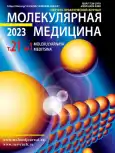Features of experimental osteoarthrosis caused by dexamethasone and talc
- Authors: Osmanova S.O.1, Osmanov O.O.1, Alimkhanova A.A.1
-
Affiliations:
- Dagestan State Medical University
- Issue: Vol 21, No 1 (2023)
- Pages: 50-55
- Section: Original research
- URL: https://journals.eco-vector.com/1728-2918/article/view/303680
- DOI: https://doi.org/10.29296/24999490-2023-01-07
- ID: 303680
Cite item
Abstract
Introduction. An experimental study of the pathogenetic mechanisms of the development of inflammatory-destructive changes in the joints in animal models was carried out in order to develop new diagnostic strategies for further implementation of the results obtained in clinical practice, determination of morphometric and metabolic features of the skeletal connective tissue of the rat knee joints.
Material and methods. The authors studied histological preparations of knee joints stained with Mayer’s hematoxylin and eosin, alcian blue (pH 1.0 and 2.5) according to Van Gieson, Masson and Mallory. The metabolic properties of cartilage and bone tissue were studied by determining the concentration of hyaluronic acid, osteocalcin, and type I collagen in the blood serum of laboratory animals.
Results. In rats with osteoarthritis induced by the administration of dexamethasone and talc, a 50% decrease in the thickness of the articular cartilage in its loaded areas was noted. There was also a violation of the spatial distribution of chondrocytes, a decrease (p<0.01) in the nuclear-cytoplasmic ratio of chondrocytes to 0.3 and an increase in the serum concentration of hyaluronic acid (p<0.001) to 110.2 ng/ml, fragments of type I collagen (p<0.001) to 217.9 ng/ml and osteocalcin (p<0.001) to 231.1 ng/ml.
Conclusion. The main pathogenetic features of experimental osteoarthritis induced by dexamethasone and talc are a violation of the density of distribution, morphological features and functional activity of chondrocytes. All this leads to inhibition of the synthesis of the components of the extracellular matrix of the articular cartilage, and is also accompanied by the activation of the destruction of proteoglycans containing non-sulfated glycosaminoglycans.
Keywords
Full Text
About the authors
Suvar O. Osmanova
Dagestan State Medical University
Author for correspondence.
Email: djami_ramazanova@mail.ru
ORCID iD: 0000-0002-1071-3747
Associate Professor, Dagestan State Medical University. PhD in Biology.
Russian Federation, pl. Lenina 1, Makhachkala, 367000Omar O. Osmanov
Dagestan State Medical University
Email: omar.osmanov.2003@inbox.ru
ORCID iD: 0000-0003-2266-2649
student of the Dagestan State Medical University
Russian Federation, pl. Lenina 1, Makhachkala, 367000Alima A. Alimkhanova
Dagestan State Medical University
Email: alimaalimhanova@mail.ru
ORCID iD: 0000-0002-1651-0369
student of the Dagestan State Medical University
Russian Federation, pl. Lenina 1, Makhachkala, 367000References
- Лапшина С.А., Мухина Р.Г., Мясоутова Л.И. Остеоартроз: современные проблемы терапии. Русский медицинский журнал. 2016; 24 (2): 95–101. doi: 10.15372/SSMJ20190203. [Lapshina S.A., Mukhina R.G., Myasoutova L.I. Osteoarthritis: modern problems of therapy. Russkiy meditsinskiy zhurnal. 2016; 24 (2): 95–101. doi: 10.15372/SSMJ20190203 (In Russian)].
- Щелкунова Е.И., Воропаева А.А., Русова Т.В., Штопис И.С. Применение экспериментального моделирования при изучении патогенеза остеоартроза (обзор литературы). Сибирский научный медицинский журнал. 2019; 39 (2): 27–39. doi: 10.15372/SSMJ20190203. [Shchelkunova E.I., Voropaeva A.A., Rusova T.V., Shtopis I.S. Application of experimental modeling in the study of the pathogenesis of osteoarthritis (literature review). Sibirskiy nauchnyy meditsinskiy zhurnal. 2019; 39 (2): 27–39. doi: 10.15372/SSMJ20190203 (In Russian)].
- Алексеева Л.И. Новые представления о патогенезе остеоартрита, роль метаболических нарушений. Ожирение и метаболизм. 2019; 16 (2): 75–82. doi: 10.14341/omet10274. [Alekseeva L.I. New ideas about the pathogenesis of osteoarthritis, the role of metabolic disorders. Ozhirenie i metabolizm. 2019; 16 (2): 75–82. doi: 10.14341/omet10274 (In Russian)].
- Патент РФ № 95106870, М. кл. G 09 B 23/28 1997. [RF Patent No. 95106870, M. cl. G09B 23/28 1997 (In Russian)].
- Kuyinu E.L., Narayanan G., Nair L.S., Laurencin C.T. Animal models of osteoarthritis: classification, update, and measurement of outcomes. Journal of Orthopaedic Surgery and Re- search. 2016; 11: 19. doi: 10.1186/s13018-016-0346-5.
- Mazor M., Best T.M., Cesaro A., Lespessailles E., Toumi H. Osteoarthritis biomarker responses and cartilage adaptation to exercise: A review of animal and human models. Scand. J. Med. Sci. Sports. 2019; 29 (8): 1072–82. DOI: 10.1111/ sms.13435.
- Cope P.J., Ourradi K., Li Y., Sharif M. Models of osteoarthritis: the good, the bad and the promising. Osteoarthritis and Carti-lage. 2019; 27 (2): 230–9. doi: 10.1016/j.joca.2018.09.016.
- Новочадов В.В., Крылов П.А., Зайцев В.Г. Неоднородность строения гиалинового хряща коленного сустава у интактных крыс и при экспериментальном остеоартрозе. Вестник Волгоградского государственного университета. Сер. 11: Естественные науки. 2014; 4: 7–16. doi: 10.15688/jvolsu11.2014.4.1. [Novochadov V.V., Krylov P.A., Zaytsev V.G. Heterogeneity of the structure of the hyaline cartilage of the knee joint in intact rats and in experimental osteoarthrosis. Vestnik Volgogradskogo gosudarstvennogo universiteta. Ser. 11: Estestvennye nauki. 2014; 4: 7–16 doi: 10.15688/jvolsu11.2014.4.1 (In Russian)].
- Lu Z., Luo M., Huang Y. IncRNA‐CIR regulates cell apop- tosis of chondrocytesin osteoarthritis. J. Cell Biochem. 2018; 120: 7229–37. doi: 10.1002/jcb.27997.
- Uthman I., Raynauld J.-P., Haraoui B. Intra-articular therapy in osteoarthritis. Postgrad. Med. J. 2003; 79: 449–53. doi: 10.1136/pmj.79.934.449.
- Szychlinska M.A., Leonardi R., Al-Qahtani M., Mobasheri A., Musumeci G. Altered joint tribology in osteoarthritis: Re- duced lubricin synthesis due to the inflammatory pro- cess. New horizons for therapeutic approaches. Annals of Physical and Rehabilitation Medicine. 2016; 59 (3): 149–56. doi: 10.1016/j.rehab.2016.03.005.
- Glasson S.S., Chambers M.G., van Den Berg W.B., Little C.B. The OARSI histopathology initiative recommendations for histological assessments of osteoarthritis in the mouse. Osteoarthritis and Cartilage. 2010; 18: 17–23. DOI: 10.1016/j. joca.2010.05.025.
- Карякина Е.В., Гладкова Е.В., Пучиньян Д.М. Структурно-метаболические особенности суставных тканей в условиях дегенеративной деструкции и ревматоидного воспаления. Российский физиологический журнал им. И.М. Сеченова. 2019; 105 (8): 989–1001. doi: 10.1134/s0869813919080065. [Karyakina E.V., Gladkova E.V., Puchin’yan D.M. Structural and metabolic features of articular tissues under conditions of degenerative destruction and rheumatoid inflammation. Rossiyskiy fiziologicheskiy zhurnal im. I.M. Sechenova. 2019; 105 (8): 989–1001. DOI: 10.1134/ s0869813919080065 (In Russian)].
- MacKay J.W., Murray P.J., Kasmai B., Johnson G., Donell S.T., Toms A.P. Subchondral bone in osteoarthritis: association between MRI texture analysis and histomorphometry. Osteo-arthritis and Cartilage. 2017; 25 (5): 700–7. DOI: 10.1016/j. joca.2016.12.011.
- Ashraf S., Mapp P.I., Walsh D.A. Contributions of angiogenesis to inflammation, joint damage, and pain in a rat model of osteoarthritis. Arthritis & Rheumatism. 2011; 63 (9): 2700–10. doi: 10.1002/art.30422.
Supplementary files







